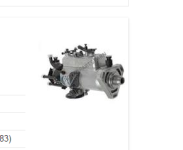Dave M7040
Elite Member
- Joined
- Dec 10, 2012
- Messages
- 2,757
- Location
- Williamstown Ontario Canada
- Tractor
- Kubota M7040 Nuffield 465
Dave
May I ask what brand/model tractor that you referred to that has fuel filters vented to fuel tank? A Ford 4500 nor my Ford 6700 don't have fuel filters vented to tank. I've been around diesel tractors since the mid 1960's and don't remember any tractors fuel filters vented to tank including my Kubota M7040 with only 2 hose fittings on filter base(photo below). Granted fuel inj pumps have a fuel return line that attaches to top of injectors then back to fuel tank.
Thanks,Jim
Jim
British tractors i.e. Leyland and Nuffield, Fordson are the ones I know have this feature and possibly some David Brown's. The banjo fitting on top of the second filter has a small orifice in it as you will see in the photo.
The banjo bolt on the top of the second fuel filter is vitally important to the running of the engine.
The banjo bolt on the top of the filter that connects to the return is a special one. It has the normal 3mm drilling up from the bottom but the cross drilling is only around 0.25mm and is only drilled through one side.
Its purpose is to allow any air that accidentally gets into the system to escape the system. Unfortunately it also allows a small amount of fuel to escape to so for this reason it is routed back to the tank. If a normal banjo bolt is used too much fuel escapes resulting in low fuel pressure being seen in the system and some injection pumps then perform sub standard!
This banjo bolt is separate from the in and out lines of the filter assembly and is located at the very top of the housing where any air would rise to and sit but because of the banjo bolt it can vent to the tank.
Also important is that the return line the banjo bolt feeds into through the orifice leads to near the bottom of the fuel tank. Often this pipe will break off and not be noticed. What happens then is that the owner begins having starting problems as air has been drawn back into the system through the broken off pipe. When the pipe is below the level of the fuel in the tank no air can be siphoned back into the fuel system as pressures drop and things cool off.
These tractors also have the common vent or drain line from each injector.


Hope this answers your question.
Dave M7040
p.s. since we are talking about unusual or new to me things, I recently learned of spring wound starters for use in countries where batteries are too expensive or unobtainable or you need a way to always start an engine. You crank the hex nut on the starter until the spring inside is fully compressed and then using the lever, release the spring's energy starting the tractor.
They start an engine much faster than a battery powered starter.
A quote from one manufacturer:
On a small engine the Startwell Starter rotates the engine through almost the same number of revolutions as an average electric starter (i.e. for approximately 3 seconds), but at a much higher speed, approximately three times as fast as a conventional electric starter. On larger engines it rotates the engine approximately twice as fast as an electric starter, allowing much less time for the heat to dissipate through the cylinder walls during a compression stroke, thus the engine cylinder rapidly reaches ignition point.

Last edited:



